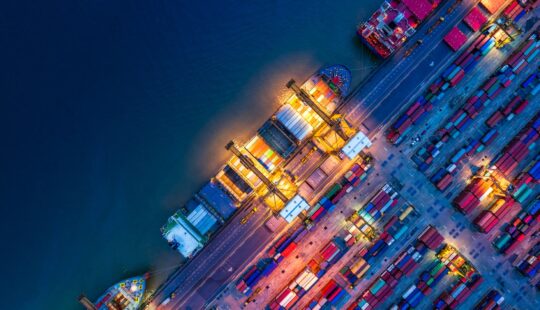If you look at almost any corporate website, you will find the company’s values, purpose, or mission. And invariably, you will find that sustainability is at the top of most companies’ lists. Whether it is corporate social responsibility, a commitment to be carbon neutral, or striving to be a player in the circular economy, sustainability is top of mind.
And if you delve a little deeper, you will see that many companies see supply chain as an area of focus to meet these goals. This was spotlighted in a recent Oxford Economics study of 1,000 supply chain executives, which found that “Sustainability will be a growing focus for organizations across industries over the coming years as they seek to meet internal goals, satisfy consumer demand, and comply with regulations.”
In addition, a majority of respondents from the study say their organizations have a plan to reduce carbon emissions (71%) Supply chain leaders (the top 12% of respondents) are even more in tune with the importance of sustainability, with 86% saying a sustainable supply chain is a competitive differentiator, compared with 68% of other respondents.
We are proud to announce that SAP won the Supply & Demand Chain Executive (SDCE) 2020 Green Supply Chain Award, which recognizes companies that are making green practices or sustainability a core part of their supply chain strategy and are working to achieve measurable sustainability goals within the global supply chain.
The Foundation for a Sustainable Supply Chain
The United Nations (UN) Global Compact has laid out 10 criteria, covering areas like environmental responsibility, labor practices, human rights, and corruption, for measuring supply chain sustainability. These principles are built upon the realization that socially responsible practices and products are not only good for people and the planet, but are also good for building positive brand awareness, competitiveness, and long-term profitability.
Social, Economic, and Environmental Sustainability Should Be at the Heart of Every Supply Chain
A sustainable supply chain is one that fully integrates ethical and environmentally responsible practices into a competitive and successful model. End-to-end supply chain transparency is critical; sustainability initiatives must extend from raw materials sourcing, to last-mile logistics, and even to product returns and recycling processes. As ethical supply chain practices become a greater and more immediate priority for businesses, compliance goals and sustainability benchmarks are also becoming more standardized.
Data from Nielsen finds that 66% of global customers are willing to pay more for sustainable goods. These customers are looking to buy from companies that:
- Design products that are biodegradable and environmentally sustainable
- Source materials ethically from organizations that follow social and humanitarian practices
- Manufacture with minimal waste and environment impact
- Deliver with logistics processes that optimize loads to reduce mileage, emissions, and carbon footprint
- Operate assets and equipment in an energy-efficient manner that is safe for the environment and workforce
While these may be daunting challenges, companies have an incentive to move forward beyond the moral imperative. Sustainable supply chain processes, after all, are good not only for the environment but also for worker safety, customer satisfaction, and – in many cases – for cost reduction as well.
Sustainability Is Here for the Long Term
Looking to the future, as the world’s population grows and natural resources decline, we are challenged to minimize waste and recycle products and materials. Pre-pandemic, we, as customers, were increasingly demanding ethically sourced products, manufactured and delivered through carbon neutral processes from sustainable companies.
Supply chain leaders were already responding to this fact, with 59% of the respondents to the Oxford study saying that customers are increasingly sensitive to such issues and 69% saying that customer demands are guiding most of their sustainability initiatives.
As we come out of the pandemic, companies will be less risk tolerant and will look to near-shore and on-shore production of key products. This will have a positive impact on carbon emissions due to a reduction in distribution.
But this is only the beginning. A large majority of leaders are already addressing sustainability issues in at least some of their products across manufacturing, engineering, and delivery, with over two-thirds (69%) saying they have implemented sustainable practices on a wide scale across these areas.
Leveraging supply chains to drive recovery in the short term and become more resilient and sustainable in the long term will be an ongoing discussion in all boardrooms.
To learn how supply chain leaders create a sustainable supply chain now and in the future, download “Surviving and Thriving: How Supply Chain Leaders Minimize Risk and Maximize Opportunities,” a research study of 1,000 COOs and chief supply chain officers.



